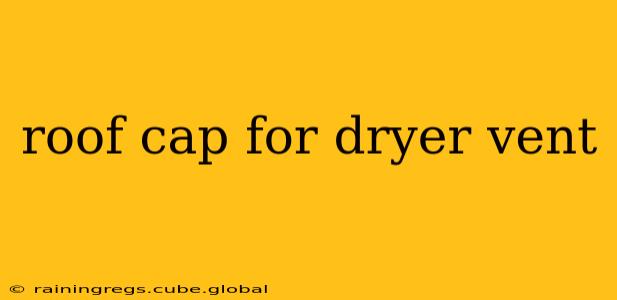A dryer vent roof cap is a crucial component of your laundry system, protecting your home from the elements and ensuring efficient dryer operation. Choosing the right one can prevent costly repairs and improve your dryer's longevity. This guide explores everything you need to know about selecting and installing a roof cap for your dryer vent.
What is a Dryer Vent Roof Cap?
A dryer vent roof cap is a protective cover placed on the exterior end of your dryer vent pipe, typically on your roof. Its primary function is to prevent rain, snow, and debris from entering the vent, which can obstruct airflow and potentially cause a fire hazard. Beyond protection, a well-designed roof cap also helps improve ventilation and maximize dryer efficiency.
Why is a Dryer Vent Roof Cap Important?
A properly functioning dryer vent is essential for safety and efficiency. Without a roof cap, several problems can arise:
- Fire Hazard: Lint buildup within the vent is a major fire risk. A roof cap helps prevent the entry of moisture which can contribute to lint build-up.
- Reduced Dryer Efficiency: Blocked vents force your dryer to work harder, leading to increased energy consumption and longer drying times.
- Water Damage: Rainwater entering the vent can lead to mold growth and water damage within your home’s structure.
- Pest Infestation: An unprotected vent can become a haven for pests and insects.
What are the Different Types of Dryer Vent Roof Caps?
Several types of dryer vent roof caps are available, each with its own advantages and disadvantages:
- Standard Caps: These are simple, inexpensive caps that offer basic protection against the elements. They are often made of plastic or metal.
- Turbine Caps: These caps utilize a spinning turbine to create a vacuum effect, drawing air out of the vent and preventing back-drafting. This improves ventilation and can be more effective at preventing debris from entering the vent.
- Louvered Caps: These caps have adjustable louvers that open to allow air to escape while closing to prevent rain and debris from entering.
- Wall Caps: If your dryer vent exits on the side of your house rather than the roof, a wall cap is needed for protection.
How Do I Choose the Right Dryer Vent Roof Cap?
Selecting the right roof cap involves considering several factors:
- Vent Diameter: Measure the diameter of your dryer vent to ensure you purchase a correctly sized cap.
- Material: Metal caps are generally more durable than plastic ones.
- Style: Consider the aesthetic appeal of the cap to match your home's style.
- Features: Choose a cap with features like a screen or turbine to maximize protection and ventilation.
How Do I Install a Dryer Vent Roof Cap?
Installation typically involves removing the existing cap (if any), attaching the new cap to the vent pipe, and sealing any gaps to prevent leaks. Consult your cap's specific installation instructions for detailed steps. Safety precautions, such as using appropriate tools and working carefully at heights, should always be followed.
How Often Should I Clean My Dryer Vent?
Regular cleaning is crucial for maintaining a safe and efficient dryer. Lint buildup can significantly reduce airflow and increase the risk of fire. Cleaning should be performed at least once a year, or more frequently if you notice reduced drying efficiency or excessive lint buildup.
What are the Signs of a Clogged Dryer Vent?
Signs of a clogged dryer vent include:
- Longer drying times: Your dryer takes significantly longer than usual to dry clothes.
- Excessive heat: Your dryer feels unusually hot to the touch during operation.
- Clothes remaining damp after a cycle: Clothes are not fully dry after a complete drying cycle.
- Musty smell from the dryer: A damp odor suggests moisture is trapped in the vent.
Can I install a dryer vent roof cap myself?
While many homeowners can install a dryer vent roof cap themselves, it’s important to assess your comfort level with heights and home repairs. If you're uncomfortable working on your roof, consider hiring a professional. Improper installation can lead to leaks, inefficient operation, and safety hazards.
This guide provides a comprehensive overview of dryer vent roof caps. Remember to prioritize safety and efficiency when selecting and installing your cap. Regular cleaning and maintenance are equally vital to ensure your dryer’s longevity and your home's safety.
